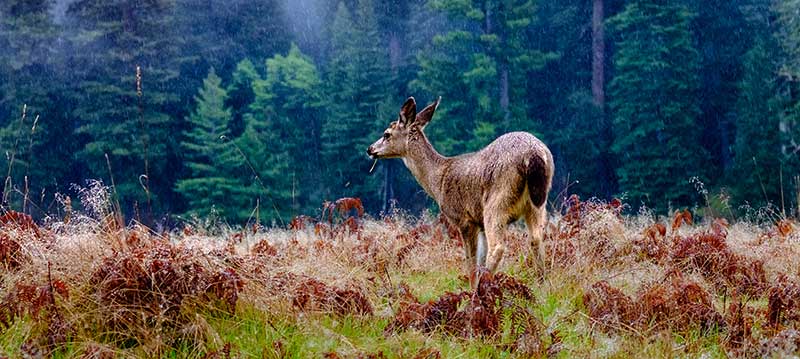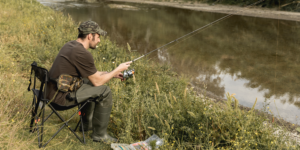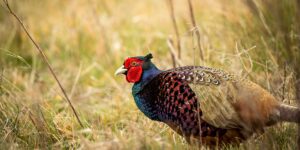Hunting deer can be an exhilarating experience, but when it’s raining outside and you’re in the woods trying to find your prey, what’s a hunter to do? Understanding deer behavior can help you make the most of your hunting trips – even when it’s wet.
Why limit yourself to public land when there are millions of acres of private land to explore.
What Do Deer Do When it Rains?
Typically, deer don’t seem to mind a light drizzle. They may pause their movements during light rain or take shelter under a tree, but they will usually continue their activities otherwise. If the hunter is careful and stealthy on rainy day hunts they may have better luck in spotting deer activity while they are stopped. Though light rain does not seem to affect deer behavior much, heavy rains and storms can cause them to become more cautious and decrease their movement significantly.
Deer Movement During Light Rain
If you don’t want to let a little precipitation stop you from hunting then there are several ways that a hunter can adjust their tactics for success. To begin with it is important for hunters to wear appropriate clothing; moisture-wicking clothes and rain gear are essential so that your body stays warm and dry despite any weather conditions. Secondly, try ambushing trails around bodies of water; because deer need liquid to stay hydrated they will often visit these areas during light rainfall. Lastly, if given time try using scents or calls as bait – although this can be difficult as noise tends to carry differently through wet environments so finding a successful call volume might require some experimenting.
During Heavy Rain or Storms
When faced with harsher conditions like a heavy downpour or storm many deer hunters prefer to take a break altogether as observing game during extreme weather can be quite difficult. However if you choose not to leave then it is best you adjust your tactics appropriately as deer may move more slowly than usual due to fatigue from walking along slick forest floors. Moreover try paying attention to areas near creek beds which tend to offer shelter while still providing access points for deer crossing into other territories.

Do Deer Act Differently After Heavy Rain?
Deer behave differently after heavy rain depending on how much has fallen over time – typically though, heavier rains usually mean increased vigilance among herds as they search for feed and shelter; whereas dry spells mean more opportunity for casual grazing within familiar territories. In either case extra caution needs to be taken in order not scare away any potential targets from their locations too quickly – sudden noises caused by displaced rocks or twigs will startle animals much easier than usual due to heightened alertness levels so keeping quiet is paramount.
Do Different Types of Deer Act Differently When it Rains?
Deer behavior varies depending on the species. Some may take shelter from light rain while others carry on with their grazing activities as usual, but heavier rains are likely to cause all types of deer to become more cautious. Whitetail and blacktail deer often become less active when faced with heavy rainfall whereas mule deer may slow down but still search for food and find refuge where possible.
Hunting Whitetail Deer in the Rain
Whitetail deer often take cover during storms and heavy rain – even more so if winds are present – which makes them harder to spot for hunters. Careful observation is required when pursuing these animals as they tend to pause their movements due to fear of being overheard by predators. However if you know the territory well then look for potential hideouts like hollows beneath trees which would allow an ambush advantage for any hunter brave enough for a wet-weather mission.
Hunting Blacktail Deer in the Rain
Blacktails usually seek shelter under thick foliage from only light rain but hardy individuals have been observed searching for grasses and other food sources during storms; either way movements will be significantly slower than usual due to slick trails or hazardous water levels meaning that stealthy approaches are far more important than usual. Moreover try finding areas near streams since these offer plenty of food like mosses or lichens that will attract attention along paths that are relatively close together making ambushing much easier even in wet conditions.
Hunting Mule Deer in the Rain
Mule deer tend to stay active even during heavy rainfall; they usually move slower because of poor terrain conditions but they still search for food sources aggressively even during stormy periods. To increase your chances of success try focusing on areas around creeks where tall vegetation can provide shelter from both extreme winds and downpour conditions – also remember that these plants act as great habitat for insects which attract mule deer looking for a quick snack.
The hassle free way to monetize your acreage.
Tips for Hunting Deer in the Rain
- When hunting whitetail deer, look for potential hiding spots like hollows under trees and be aware that movement may become more stealthy during heavy rain.
- For blacktail deer, focus on areas near streams which can provide food sources, and try to approach these deer as quietly as possible.
- Mule deer remain active even in extreme rains, so keep an eye out for tall vegetation around creeks which offer food sources and protection from strong winds and downpours. Rain may also limit a mule deer’s ability to detect human scent, but take caution when taking advantage of this.



